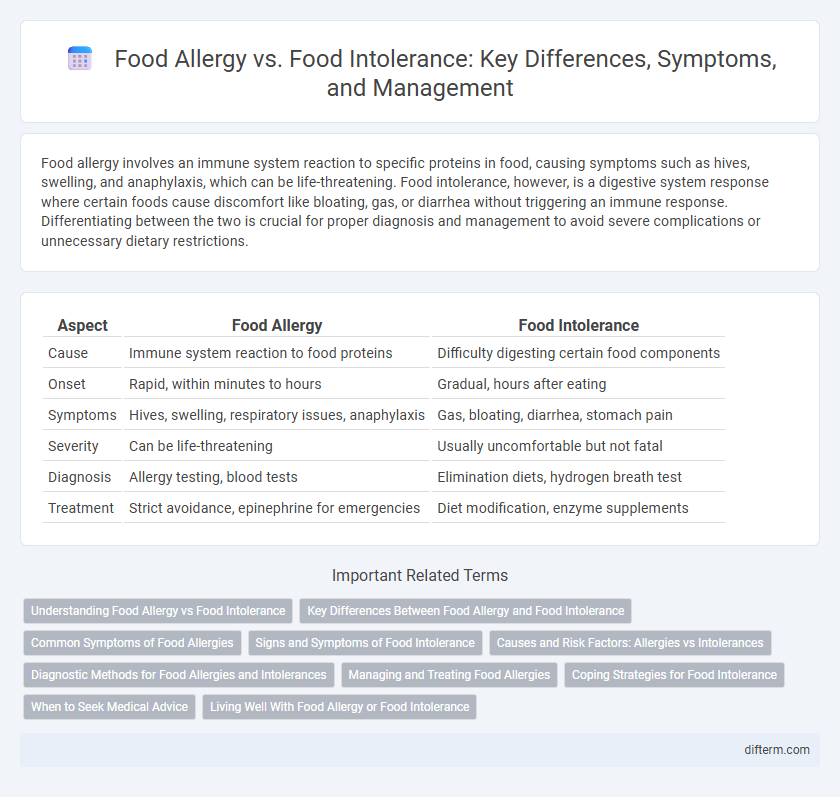Food allergy involves an immune system reaction to specific proteins in food, causing symptoms such as hives, swelling, and anaphylaxis, which can be life-threatening. Food intolerance, however, is a digestive system response where certain foods cause discomfort like bloating, gas, or diarrhea without triggering an immune response. Differentiating between the two is crucial for proper diagnosis and management to avoid severe complications or unnecessary dietary restrictions.
Table of Comparison
| Aspect | Food Allergy | Food Intolerance |
|---|---|---|
| Cause | Immune system reaction to food proteins | Difficulty digesting certain food components |
| Onset | Rapid, within minutes to hours | Gradual, hours after eating |
| Symptoms | Hives, swelling, respiratory issues, anaphylaxis | Gas, bloating, diarrhea, stomach pain |
| Severity | Can be life-threatening | Usually uncomfortable but not fatal |
| Diagnosis | Allergy testing, blood tests | Elimination diets, hydrogen breath test |
| Treatment | Strict avoidance, epinephrine for emergencies | Diet modification, enzyme supplements |
Understanding Food Allergy vs Food Intolerance
Food allergy involves an immune system reaction to specific proteins in food, often causing symptoms like hives, swelling, or anaphylaxis. Food intolerance relates to digestive system responses, such as bloating or diarrhea, usually due to enzyme deficiencies or sensitivity to food additives. Distinguishing between these conditions is crucial for proper diagnosis and management to avoid potentially severe health risks.
Key Differences Between Food Allergy and Food Intolerance
Food allergy involves an immune system reaction triggered by specific proteins in food, causing symptoms like hives, swelling, or anaphylaxis, which can be life-threatening. Food intolerance occurs when the digestive system cannot properly break down certain foods, leading to symptoms such as bloating, gas, and diarrhea, but it does not involve an immune response. Diagnosis for allergies often requires skin tests or blood tests, whereas intolerance is usually identified through elimination diets and symptom tracking.
Common Symptoms of Food Allergies
Common symptoms of food allergies include hives, swelling, itching, and difficulty breathing, often occurring within minutes to hours after consuming the allergenic food. Anaphylaxis, a severe and potentially life-threatening reaction, may manifest through rapid pulse, dizziness, and throat constriction. Unlike food intolerance, which primarily affects the digestive system, food allergies activate the immune response, leading to systemic symptoms.
Signs and Symptoms of Food Intolerance
Food intolerance primarily causes digestive symptoms such as bloating, gas, diarrhea, and stomach pain due to the body's inability to properly digest certain foods. Unlike food allergies, food intolerance symptoms typically develop gradually and are less likely to involve the immune system, avoiding severe reactions like anaphylaxis. Common intolerances include lactose intolerance and gluten sensitivity, with symptoms often triggered by consuming specific quantities of the offending food.
Causes and Risk Factors: Allergies vs Intolerances
Food allergies are caused by an abnormal immune system response to specific proteins in foods such as peanuts, shellfish, or eggs, often triggered by genetic predisposition and early exposure to allergens. In contrast, food intolerances result from the digestive system's inability to properly break down certain substances, like lactose intolerance caused by lactase enzyme deficiency or sensitivity to food additives. Risk factors for allergies include family history of allergic conditions and other allergic diseases, while intolerances are more related to enzyme deficiencies, gut health issues, and consumption patterns.
Diagnostic Methods for Food Allergies and Intolerances
Diagnostic methods for food allergies primarily include skin prick tests, serum-specific IgE measurements, and oral food challenges, which help identify immune system reactions. Food intolerance diagnosis relies on elimination diets and hydrogen breath tests to detect enzyme deficiencies or adverse reactions without involving the immune system. Accurate diagnosis differentiates between the IgE-mediated response in allergies and the non-immune digestive issues seen in intolerances, guiding appropriate treatment plans.
Managing and Treating Food Allergies
Managing food allergies requires strict avoidance of allergenic foods and immediate access to emergency medications such as epinephrine auto-injectors to treat anaphylactic reactions. Regular consultations with allergists help develop personalized action plans, including identifying hidden allergens and ensuring safe food consumption. Immunotherapy and emerging treatments may improve tolerance over time but must be supervised by healthcare professionals to prevent severe allergic responses.
Coping Strategies for Food Intolerance
Managing food intolerance involves identifying trigger foods through an elimination diet and carefully monitoring symptoms to prevent discomfort. Incorporating enzyme supplements like lactase for lactose intolerance can enhance digestion and improve tolerance to certain foods. Maintaining clear communication with healthcare providers and using food diaries helps tailor dietary adjustments for long-term symptom relief and improved quality of life.
When to Seek Medical Advice
Seek medical advice promptly if experiencing severe symptoms like anaphylaxis, including difficulty breathing, swelling, or rapid heartbeat, which typically indicate a food allergy. Persistent gastrointestinal distress, such as bloating, diarrhea, or abdominal pain occurring after specific food intake, may signal food intolerance and warrants professional evaluation. Early diagnosis and treatment by allergists or gastroenterologists can prevent complications and improve dietary management.
Living Well With Food Allergy or Food Intolerance
Managing food allergies and intolerances requires careful identification of triggers and strict avoidance of offending foods to prevent adverse reactions and maintain overall well-being. Implementing personalized meal plans and carrying emergency medication like antihistamines or epinephrine auto-injectors ensures safety and peace of mind. Building awareness through education and support networks boosts confidence, allowing individuals to navigate social situations and enjoy a balanced, nutritious diet without compromising health.
Food Allergy vs Food Intolerance Infographic

 difterm.com
difterm.com